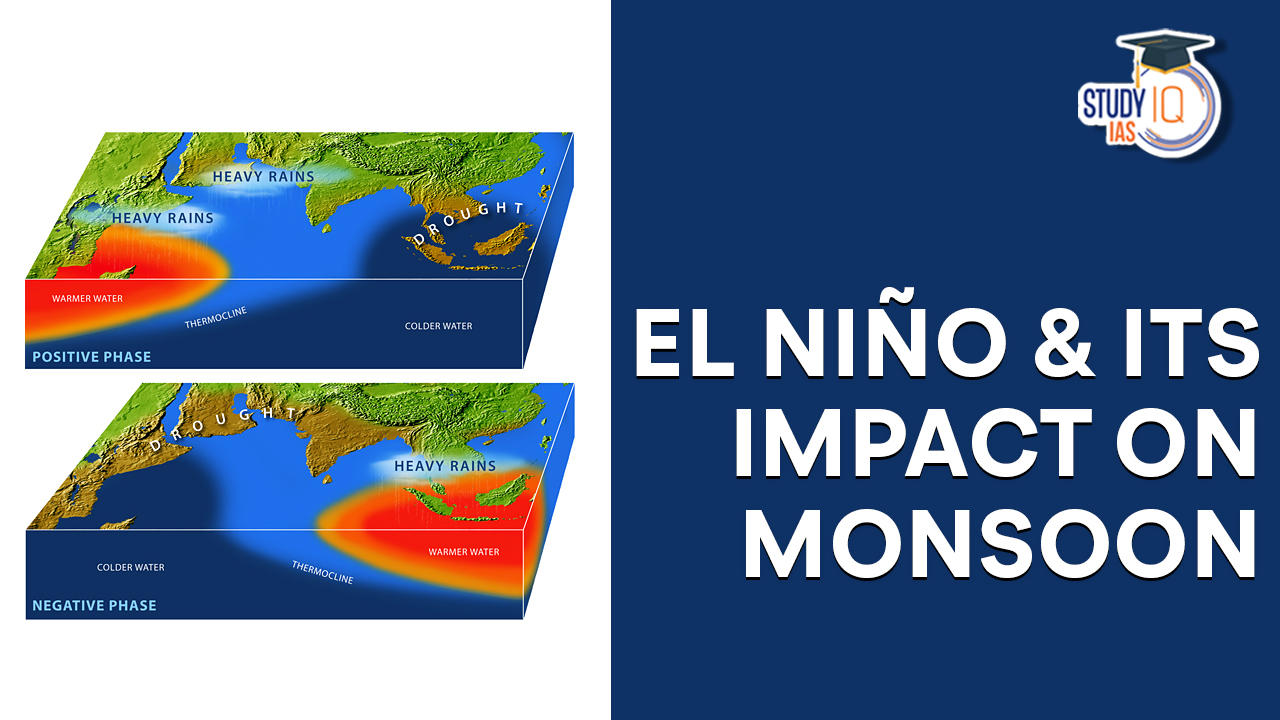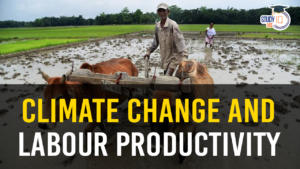Table of Contents
Context: The India Meteorological Department (IMD) said that a strengthening El Nino could suppress rainfall in the second half of the monsoon.
What is El Niño?
- The term El Niño (Spanish for ‘the Christ Child’) refers to a warming of the ocean surface, or above-average sea surface temperatures, in the central and eastern tropical Pacific Ocean.
- It is part of a larger climate pattern known as the El Niño Southern Oscillation (ENSO).
About El Niño–Southern Oscillation (ENSO)
- The ENSO is a recurring climate pattern involving changes in the temperature of waters in the central and eastern tropical Pacific Ocean.
- On periods ranging from about three to seven years, the surface waters across a large swath of the tropical Pacific Ocean warm or cool by anywhere from 1°C to 3°C, compared to normal.
- This oscillating warming and cooling pattern, referred to as the ENSO cycle, directly affects rainfall distribution in the tropics and can have a strong influence on weather across the world.
- ENSO has three phases: El Niño, La Niña, and neutral, which are associated with different temperature and atmospheric conditions.
- El Niño occurs when the surface water temperature in the eastern Pacific Ocean becomes warmer than usual, and this warming can last for several months to a few years.
- La Niña occurs when the surface water temperature in the eastern Pacific Ocean becomes cooler than usual, and this cooling can also last for several months to a few years.
- Neutral conditions occur when the sea surface temperatures in the eastern Pacific Ocean are close to average, with no significant warming or cooling.
- Why it happens? The exact causes of ENSO are complex and not fully understood, but scientists believe that changes in ocean and atmospheric circulation patterns, as well as variations in solar radiation and other factors, play a role in triggering and modulating ENSO events.
- Impact of climate change on ENSO:
- Climate change could lead to more frequent and more intense El Niño and La Niña events, which could have a significant impact on global climate patterns.
- Another potential impact is that warmer sea surface temperatures could alter the location and intensity of the Pacific Ocean’s subtropical gyres, which could influence the onset and strength of ENSO events.
The Mechanism of El Niño
- During an El Niño event, there is a weakening or even a reversal of the trade winds along the equator, which disrupts the normal pattern.
- Normally, strong trade winds blow westward across the tropical Pacific, the region of the Pacific Ocean located between the Tropic of Cancer and the Tropic of Capricorn.
- These winds push warm surface water toward the western Pacific, where it borders Asia and Australia.
- The westward movement of warmer waters causes cooler waters to rise up toward the surface on the coasts of Ecuador, Peru, and Chile. This process is known as upwelling.
- This weakening of the trade winds allows warm surface waters to move eastward, accumulating in the central and eastern Pacific.
- As a result, the thermocline (the boundary between warm surface waters and cooler waters below) becomes sloped, with the warm water layer becoming deeper in the eastern Pacific.
- During an El Niño event, the thermocline can dip as far as 152 meters (500 feet).
- The warm ocean temperatures in the eastern Pacific have profound effects on the atmosphere above.
- The warm water heats the overlying air, causing it to rise and create an area of low atmospheric pressure, disrupting the normal atmospheric circulation patterns.
Impacts of El Niño
- Changes in Precipitation Patterns: El Niño can disrupt normal rainfall patterns, leading to droughts and reduced precipitation in some regions and increased rainfall in others.
- For example, during El Niño events, there is often reduced rainfall in parts of Southeast Asia, Australia, and parts of Africa, while increased rainfall occurs in the central and eastern Pacific, including coastal areas of South America.
- Due to El Niño, rainfall increases drastically in Ecuador and northern Peru, contributing to coastal flooding and erosion.
- At the same time, El Niño brings droughts to Indonesia and Australia.
- Fisheries and Marine Ecosystems: El Niño disrupts marine ecosystems, particularly in the eastern Pacific. The absence of cold, nutrient-rich upwelling waters during El Niño reduces the availability of food for marine organisms, leading to declines in fish populations and impacts on fishing industries.
- Global Climate Patterns: Stronger El Niño events also disrupt global atmospheric circulation.
- The eastward movement of oceanic and atmospheric heat sources cause unusually severe winter weather at the higher latitudes of North and South America.
- Regions as far north as the U.S. states of California and Washington may experience longer, colder winters because of El Niño.

- Tropical Cyclone Activity: El Niño can influence the frequency and intensity of tropical cyclones (hurricanes, typhoons) in different parts of the world.
- For example, the Atlantic hurricane season tends to be less active during El Niño due to increased wind shear, which can inhibit cyclone development.
- In the Western Pacific basins there is a change in location of tropical cyclones without a total change in frequency during a El Niño event.
Impact of El Niño on Indian Monsoon
- Weakening of Monsoon Winds: During El Niño years, the trade winds across the Pacific weaken, reducing their ability to push moisture-laden air towards the Indian subcontinent. As a result, the monsoon winds over the Indian Ocean and the Arabian Sea weaken, leading to a decrease in the overall strength of the monsoon.
- Shift in Rainfall Patterns: The regions that typically receive abundant rainfall during the monsoon season may experience below-average rainfall, while regions that usually receive less rainfall may receive more. This spatial redistribution of rainfall can have significant implications for agriculture, water resources, and ecosystems.
- Delayed Onset and Early Withdrawal: El Niño events can delay the onset of the monsoon season in India. Similarly, El Niño can lead to an early withdrawal of the monsoon, shortening the overall duration of the rainy season.
‘Flavors’ of El Niño
- Variations of El Niño are referred to as “flavors.”
- Trans Niño: The transition period of an El Niño event, for instance, is called a “Trans Niño.” Trans Niño events occur at the onset and closing of an El Niño event.
- Trans Niño events often include increased tornado activity in the American Midwest.
- El Niño Modoki: Another “flavor” of El Niño is the El Niño Modoki, or Modoki Niño.
- Modoki is a Japanese word meaning “similar, but different.”
- Modoki Niño, also called the Central Pacific Niño, is characterized by changes in sea-surface temperatures in the central, not eastern, Pacific.
- Some Modoki Niño events are distinct from traditional El Niño events, such as increased hurricane activity in the Atlantic and Gulf of Mexico.


 Current Affairs 2nd May 2024 for UPSC Pr...
Current Affairs 2nd May 2024 for UPSC Pr...
 Article 31C, Origin, Challenges and Curr...
Article 31C, Origin, Challenges and Curr...
 Climate Change and Labour Productivity
Climate Change and Labour Productivity

















